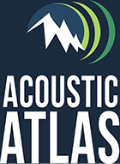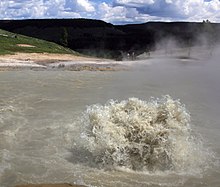Acoustic Atlas
| Acoustic Atlas | |
|---|---|
 | |
| Commercial? | No |
| Type of project | Audio archive |
| Location | Montana State University Library, United States |
| Key people | Jeff Rice; Kenning Arlitsch; Doralyn Rossmann; Steve Hunts; Jim Espeland |
| Established | February 1, 2013 |
| Website | acousticatlas |
Acoustic Atlas is a repository of sound recordings from the Western United States, including sounds made by animals, ambient recordings of environments, and interviews related to the topic of natural sounds. The collection is hosted by the Montana State University Library, and it is a collaboration between the library and Yellowstone National Park. The project focuses on the collection and dissemination of natural sounds of Montana and the Greater Yellowstone Ecosystem, along with habitats and species from throughout the contiguous Western United States.
Purpose and scope[edit]
The Acoustic Atlas was founded in 2013 by Montana State University Library to create an audio archive to document regional ecosystems and biodiversity amid the impact of growing human populations in the Intermountain West region of the United States.[1][2] The collection also includes Hawaii.[3] The archive includes more than 3000 online audio recordings of a range of animal sounds and environmental soundscapes.[4] Sounds in the collection are provided by recordists who are contractors, volunteers, researchers, and federal agencies such as the National Park Service.[2] All recordings are available to the public; many sounds are available for download and in the public domain.[5]
The mission of the Acoustic Atlas is to archive rare and under-represented recordings of species and environments and "to document natural soundscapes that are increasingly impeded by human activity and development."[4]
Types of recordings[edit]
The Acoustic Atlas includes relatively short recordings of sounds made by wildlife; longer ambient soundscapes that capture the collective sounds of natural environments; and interviews with scientists and other experts on subjects related to natural sounds.[6] These recordings are organized into categories based on taxonomic class, features of the environment (including water, weather, and geology), or dynamic chemical processes such as fire or photosynthesis.[7] Human-sourced sounds are included when they occur incidentally in environmental recordings[6] and are typically classified as anthropogenic noise.[8]
The collected and organized recordings of animal calls, such as deer and birds, can show differences in "dialects" between populations in different regions.[6] Some of the interviews discuss the practice of making recordings of wildlife, such as a recordist talking about holding ants in his teeth to get a recording of their sounds.[6][9]
Some sounds are recorded in places of specific historic significance, such as the Trinity site at White Sands Missile Range in New Mexico.[10]
Sub-collections[edit]

The archive's sub-collections include the sounds of terrestrial vertebrate species, species and soundscapes of Yellowstone National Park, and recordings from the grassland ecosystems of Montana. Since 2017, the archive has been developing a collection of ambisonic recordings made at locations within Montana and other Western states.[12]
The Soundscapes of Ivan Doig includes soundscape recordings and interviews from the lands and peoples featured in some of the American author's 16 novels.[11] This sub-collection includes the Wind from Eden Podcast and The History of Weather in Doig Country.
Yellowstone National Park[edit]

In 2013, the Acoustic Atlas began collaborating with Yellowstone National Park to record and archive sounds from the park. This collaboration supports the creation of new field recordings, along with a podcast series that was jointly produced by Yellowstone National Park and the Acoustic Atlas from 2017 to 2019.[13] Audio producer Jennifer Jerrett recorded many of the sounds in this collection, both natural and human.[14] The project was partly funded by the Yellowstone Association and Yellowstone Park Foundation.[15]
Uses[edit]
In 2018, the mapping software company Esri worked with the Acoustic Atlas to develop the ArcGIS StoryMap "Sounds of the Wild West: An audio tour of Montana's four major ecosystems."[16] The Esri team incorporated both GIS data and sound in this platform.[17]
Sounds from the archive have been used in the film Walking Out (2017),[18] an exhibit at the Natural History Museum of Utah in 2019–2020,[19] radio programs on WBUR[20][21] and Montana Public Radio,[22] and a New York Times Magazine multimedia exhibit about sounds around the world.[23]
Many of the sounds are also available for independent producers and song composers to use.[24]
References[edit]
- ^ McGonigal, Chris; Offenberg, Nick (March 1, 2017). "The Sounds Of Yellowstone National Park Remind Us Why It's Worth Preserving". HuffPost. Retrieved May 3, 2022.
- ^ a b Brulliard, Nicolas (Summer 2016). "Surround Sound: The Acoustic Atlas' trove of recordings include grizzly cubs purring, ice freezing, and thousands of other elusive sounds". National Parks Conservation Association. Retrieved May 3, 2022.
- ^ "New Podcasts Reveal Hidden Stories of Hawai'i". Big Island Now. September 18, 2019. Retrieved May 5, 2022.
- ^ a b "About Acoustic Atlas". Acoustic Atlas: Montana State University Library. Retrieved July 7, 2022.
- ^ "Yellowstone National Park share a huge catalogue of free ambient sounds". Happy. September 8, 2021. Retrieved February 6, 2022.
- ^ a b c d e French, Brett (December 5, 2013). "A sound signature: MSU compiling regional Acoustic Atlas". The State Journal-Register. Associated Press. Retrieved July 27, 2022.
- ^ Rice, Jeff (April 1, 2016). "Sound production in two species of eelgrass". The Journal of the Acoustical Society of America. 139 (4): 2227. Bibcode:2016ASAJ..139R2227R. doi:10.1121/1.4950692 – via asa.scitation.org (Atypon).
- ^ "Sounds Of Yellowstone National Park To Be Captured For Posterity". National Parks Traveler. June 27, 2015. Retrieved August 3, 2022.
- ^ Rice, Jeff. "Interview with Dr. Hayward Spangler on ant sounds". Acoustic Atlas. Montana State University Library. Retrieved August 2, 2022.
- ^ Rice, Jeff (July 16, 2018). "The toads of Trinity: witnesses to the atomic age". Here and Now. WBUR. Retrieved February 5, 2022.
- ^ a b "Ivan Doig Archive – Soundscapes of Ivan Doig". Montana State University Library. Retrieved July 9, 2022.
- ^ "Ambisonic Collection". Acoustic Atlas: Montana State University Library. Retrieved August 21, 2022.
- ^ "'Listen' to sounds of Yellowstone". Cody Enterprise. January 28, 2016. Retrieved July 9, 2022.
- ^ Yamanaka, Jackie (January 28, 2016). "The Sounds of Yellowstone are now available online". Yellowstone Public Radio. Retrieved February 5, 2022.
- ^ Reichard, Sean (January 28, 2016). "Yellowstone, MSU's Acoustic Atlas Debut GYE Audio Collection". Yellowstone Insider. Retrieved February 20, 2022.
- ^ "Sounds of the Wild West: An audio tour of Montana's four major ecosystems". ESRI. 2018. Retrieved July 9, 2022.
- ^ Cantrell, Anne (January 8, 2019). "Montana ecosystems come to life through sounds in new project". Montana Standard. Retrieved July 9, 2022.
- ^ "Sounds for new film at Sundance". Montana State University Library. Retrieved May 5, 2022.
- ^ "Many Acoustic Atlas recordings can be heard in an incredible new exhibit at the Natural History Museum of Utah". Twitter. October 20, 2019. Retrieved July 8, 2022.
- ^ Hobson, Jeremy (December 28, 2016). "'These sounds could go away': preserving the natural ambiance of Yellowstone". WBUR Here & Now. Retrieved February 21, 2022.
- ^ Hobson, Jeremy (August 22, 2016). "How one audio archivist works to preserve Yellowstone's iconic sounds". Here and Now. WBUR. Retrieved February 5, 2022.
- ^ Jerrett, Jennifer (February 12, 2016). "To catch a Loon". Montana Public Radio. Retrieved February 5, 2022.
- ^ "Listen to the World". New York Times Magazine. September 21, 2018. Retrieved July 9, 2022.
- ^ Shackleford, Tom (January 7, 2019). "Yellowstone audio samples keep national parks' spirit alive during government shutdown". Live for Live Music. Retrieved February 21, 2022.
